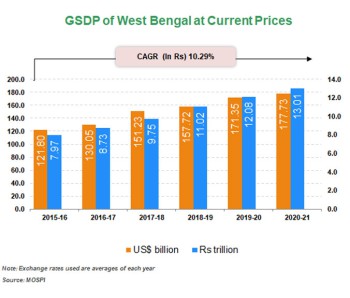INTRODUCTION
West Bengal is situated in eastern India and shares its borders with Jharkhand, Bihar, Odisha, Sikkim, and Assam. The state also shares international borders with Bangladesh, Bhutan, and Nepal. The Bay of Bengal is in the south of West Bengal.
At current prices, Gross State Domestic Product (GSDP) of West Bengal is estimated at Rs 14.44 trillion (US$ 206.64 billion) in 2020-21. The average annual GSDP growth rate from 2015-16 to 2020-21 is about 12.62%.
West Bengal is the largest producer of rice in India. Rice production for the state totalled 14.99 million tonnes in 2017-18. West Bengal is also a major producer of fish. During 2018-19, the state produced a total of 1.85 million tonnes of fish.
West Bengal is the second largest tea-producing state in India and is home to the globally acclaimed Darjeeling tea variety.
Its location advantage makes the state a traditional market for eastern India, the Northeast, Nepal, and Bhutan. It is also a strategic entry point for markets in Southeast Asia. The cost of operating a business is lower in Kolkata than in other metropolitan cities.
West Bengal has abundant natural resources of minerals and suitable agro-climatic conditions for agriculture, horticulture, and fisheries. It is in vicinity to mineral rich states like Jharkhand, Bihar, and Odisha. It offers excellent connectivity to the rest of India in terms of railways, roadways, ports, and airports.
As of April 2021, West Bengal had a total installed power generation capacity of 11,036.88 MW, of which 6,497.95 MW was under state utilities, 2,883.31 MW (private sector) and 1,655.62 MW (central utilities).
Of the total installed power capacity, 9,072.62 MW was contributed by thermal power, 1,396.00 MW by hydropower and 568.26 MW by renewable power.
Between October 2019 and March 2021, FDI inflows in West Bengal stood at US$ 605.17 million.
West Bengal ranked eleventh among Indian states on ease of doing business and reforms implementation according to a study by the World Bank and KPMG.



KEY SECTORS
- In 2018-19, West Bengal remained the second largest producer of potato in India, accounting for about 24.31% of the country’s potato output. The state’s potato production stood at 13.78 million tonnes in 2018-19.
- As of October 2020, West Bengal had 21 SEZs; of this, seven were operational, five were notified, seven were formally approved and two had in-principle approval.
- As per State Budget 2021-22, the government has allocated Rs. 183.51 crore (US$ 25.35 million) for development of the IT and Electronics Department in West Bengal.
- Total tea production in West Bengal stood at 415.89 million kgs in 2019-20, accounting for 29.27% share of India’s total production.
- The state is the largest producer of rice.
- Moreover, the state is also a key producer of petroleum and petrochemicals. Production of natural gas in the state^ reached 534 million cubic metres in 2020-21*.
- Total export from IT sector from the state was estimated at Rs 22,897 crore (US$ 3.28 billion) in 2018-19. The State Government introduced West Bengal Information Technology and Electronics Policy 2018 which envisages West Bengal as one of the leading states in India in the IT, ITeS, ICT and ESDM sectors.
Note: ^including Madhya Pradesh and Jharkhand, * – Until January 2021